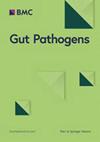Etiology of diarrheal hospitalizations following rotavirus vaccine implementation and association of enteric pathogens with malnutrition among under-five children in India
IF 4.3
3区 医学
Q1 GASTROENTEROLOGY & HEPATOLOGY
引用次数: 0
Abstract
Malnourished children are at higher risk of mortality and morbidity following diarrheal illness and certain enteropathogens have been associated with malnutrition in children. Very few studies have comprehensively looked at the etiology of diarrhea in malnourished children and most have used conventional diagnostic methods with suboptimal sensitivity. We used a highly sensitive molecular approach against a broad range of pathogens causing diarrhea and examined their association with malnutrition. In addition, we looked at the pathogen diversity of pediatric diarrhea, three years after the nationwide rotavirus vaccine introduction to understand the evolving landscape of pathogens, which is crucial for planning strategies to further reduce the diarrhea burden. Clinical details and diarrheal stool samples were collected from hospitalized children aged < 5 years from three sentinel sites in India for a period of one year. The samples were tested by qPCR for 16 established causes of diarrhea using TaqMan Array Cards. A total of 772 children were enrolled, from whom 482 (62.4%) stool specimens were tested. No specific pathogen was associated with diarrhea among children with acute or chronic malnutrition compared to those with better nutritional status. Overall, adenovirus was the leading pathogen (attributable fraction (AF) 16.9%; 95% CI 14.1 to 19.2) followed by rotavirus (AF 12.6%; 95% CI 11.8 to 13.1) and Shigella (AF 10.9%; 95% CI 8.4 to 16.4). The majority of diarrhea requiring hospitalization in children aged < 2 years could be attributed to viruses, while Shigella was the most common pathogen among children aged > 2 years. These data on the prevalence and epidemiology of enteropathogens identified potential pathogens for public health interventions.印度五岁以下儿童接种轮状病毒疫苗后腹泻住院的病因以及肠道病原体与营养不良的关系
营养不良的儿童患腹泻病后死亡和发病的风险较高,某些肠道病原体与儿童营养不良有关。很少有研究对营养不良儿童腹泻的病因进行了全面研究,而且大多数研究都采用了灵敏度不高的传统诊断方法。我们采用了一种高灵敏度的分子方法来检测引起腹泻的多种病原体,并研究了它们与营养不良的关系。此外,我们还研究了在全国范围内引入轮状病毒疫苗三年后小儿腹泻病原体的多样性,以了解病原体的演变情况,这对于规划进一步减轻腹泻负担的策略至关重要。研究人员收集了住院的 2 岁儿童的临床资料和腹泻粪便样本。这些有关肠道病原体流行和流行病学的数据为公共卫生干预措施确定了潜在的病原体。
本文章由计算机程序翻译,如有差异,请以英文原文为准。
求助全文
约1分钟内获得全文
求助全文
来源期刊

Gut Pathogens
GASTROENTEROLOGY & HEPATOLOGY-MICROBIOLOGY
CiteScore
7.70
自引率
2.40%
发文量
43
期刊介绍:
Gut Pathogens is a fast publishing, inclusive and prominent international journal which recognizes the need for a publishing platform uniquely tailored to reflect the full breadth of research in the biology and medicine of pathogens, commensals and functional microbiota of the gut. The journal publishes basic, clinical and cutting-edge research on all aspects of the above mentioned organisms including probiotic bacteria and yeasts and their products. The scope also covers the related ecology, molecular genetics, physiology and epidemiology of these microbes. The journal actively invites timely reports on the novel aspects of genomics, metagenomics, microbiota profiling and systems biology.
Gut Pathogens will also consider, at the discretion of the editors, descriptive studies identifying a new genome sequence of a gut microbe or a series of related microbes (such as those obtained from new hosts, niches, settings, outbreaks and epidemics) and those obtained from single or multiple hosts at one or different time points (chronological evolution).
 求助内容:
求助内容: 应助结果提醒方式:
应助结果提醒方式:


